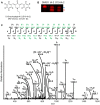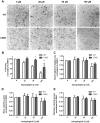Identification of T. gondii myosin light chain-1 as a direct target of TachypleginA-2, a small-molecule inhibitor of parasite motility and invasion
- PMID: 24892871
- PMCID: PMC4043638
- DOI: 10.1371/journal.pone.0098056
Identification of T. gondii myosin light chain-1 as a direct target of TachypleginA-2, a small-molecule inhibitor of parasite motility and invasion
Abstract
Motility of the protozoan parasite Toxoplasma gondii plays an important role in the parasite's life cycle and virulence within animal and human hosts. Motility is driven by a myosin motor complex that is highly conserved across the Phylum Apicomplexa. Two key components of this complex are the class XIV unconventional myosin, TgMyoA, and its associated light chain, TgMLC1. We previously showed that treatment of parasites with a small-molecule inhibitor of T. gondii invasion and motility, tachypleginA, induces an electrophoretic mobility shift of TgMLC1 that is associated with decreased myosin motor activity. However, the direct target(s) of tachypleginA and the molecular basis of the compound-induced TgMLC1 modification were unknown. We show here by "click" chemistry labelling that TgMLC1 is a direct and covalent target of an alkyne-derivatized analogue of tachypleginA. We also show that this analogue can covalently bind to model thiol substrates. The electrophoretic mobility shift induced by another structural analogue, tachypleginA-2, was associated with the formation of a 225.118 Da adduct on S57 and/or C58, and treatment with deuterated tachypleginA-2 confirmed that the adduct was derived from the compound itself. Recombinant TgMLC1 containing a C58S mutation (but not S57A) was refractory to click labelling and no longer exhibited a mobility shift in response to compound treatment, identifying C58 as the site of compound binding on TgMLC1. Finally, a knock-in parasite line expressing the C58S mutation showed decreased sensitivity to compound treatment in a quantitative 3D motility assay. These data strongly support a model in which tachypleginA and its analogues inhibit the motility of T. gondii by binding directly and covalently to C58 of TgMLC1, thereby causing a decrease in the activity of the parasite's myosin motor.
Conflict of interest statement
Figures






Similar articles
-
Blocking Palmitoylation of Toxoplasma gondii Myosin Light Chain 1 Disrupts Glideosome Composition but Has Little Impact on Parasite Motility.mSphere. 2021 May 19;6(3):e00823-20. doi: 10.1128/mSphere.00823-20. mSphere. 2021. PMID: 34011689 Free PMC article.
-
A small-molecule inhibitor of T. gondii motility induces the posttranslational modification of myosin light chain-1 and inhibits myosin motor activity.PLoS Pathog. 2010 Jan 15;6(1):e1000720. doi: 10.1371/journal.ppat.1000720. PLoS Pathog. 2010. PMID: 20084115 Free PMC article.
-
A Toxoplasma gondii class XIV myosin, expressed in Sf9 cells with a parasite co-chaperone, requires two light chains for fast motility.J Biol Chem. 2014 Oct 31;289(44):30832-30841. doi: 10.1074/jbc.M114.572453. Epub 2014 Sep 17. J Biol Chem. 2014. PMID: 25231988 Free PMC article.
-
'The glideosome': a dynamic complex powering gliding motion and host cell invasion by Toxoplasma gondii.Mol Microbiol. 2002 Aug;45(3):597-604. doi: 10.1046/j.1365-2958.2002.03056.x. Mol Microbiol. 2002. PMID: 12139608 Review.
-
The role of the cytoskeleton in host cell invasion by Toxoplasma gondii.Behring Inst Mitt. 1997 Mar;(99):90-6. Behring Inst Mitt. 1997. PMID: 9303207 Review.
Cited by
-
Myosin light chains: Teaching old dogs new tricks.Bioarchitecture. 2014;4(6):169-88. doi: 10.1080/19490992.2015.1054092. Bioarchitecture. 2014. PMID: 26155737 Free PMC article. Review.
-
Motility-dependent processes in Toxoplasma gondii tachyzoites and bradyzoites: same same but different.bioRxiv [Preprint]. 2024 Sep 28:2024.09.28.615543. doi: 10.1101/2024.09.28.615543. bioRxiv. 2024. Update in: mSphere. 2025 Mar 25;10(3):e0085524. doi: 10.1128/msphere.00855-24. PMID: 39386639 Free PMC article. Updated. Preprint.
-
Calcium-dependent phosphorylation alters class XIVa myosin function in the protozoan parasite Toxoplasma gondii.Mol Biol Cell. 2014 Sep 1;25(17):2579-91. doi: 10.1091/mbc.E13-11-0648. Epub 2014 Jul 2. Mol Biol Cell. 2014. PMID: 24989796 Free PMC article.
-
Blocking Palmitoylation of Toxoplasma gondii Myosin Light Chain 1 Disrupts Glideosome Composition but Has Little Impact on Parasite Motility.mSphere. 2021 May 19;6(3):e00823-20. doi: 10.1128/mSphere.00823-20. mSphere. 2021. PMID: 34011689 Free PMC article.
-
Systematic analysis of Plasmodium myosins reveals differential expression, localisation, and function in invasive and proliferative parasite stages.Cell Microbiol. 2019 Oct;21(10):e13082. doi: 10.1111/cmi.13082. Epub 2019 Jul 23. Cell Microbiol. 2019. PMID: 31283102 Free PMC article.
References
Publication types
MeSH terms
Substances
Grants and funding
LinkOut - more resources
Full Text Sources
Other Literature Sources

